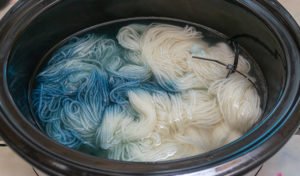Handmade dyed yarn: Two Bases, One Pot on Marshmallow
MARSHMALLOW is a beautiful, 4-ply yarn that comes in two weights: Worsted and DK. Today on the blog, we will dye one skein of MARSHMALLOW DK SELECT and MARSHMALLOW WORSTED SELECT in the same dye pot to show off the beautiful absorption of dye and the differences in weights between these two yarns. This soft, sturdy yarn dyes up with vibrant pigmentation, and today we will be highlighting that quality by dyeing a mountain river-inspired colorway in shades of green and blue. Let’s get started!
SUPPLIES
- One skein MARSHMALLOW DK SELECT
- One skein MARSHMALLOW WORSTED SELECT
- Teaspoon set
- Tablespoon
- Measuring cups
- Spoon
- Citric Acid
- Dharma Acid Dye in Peacock Blue, Lichen, and Pistachio
- Three glass jars
- Masking tape and marker
- Slow cooker or steel pot with lid + heat source
- Tongs
- Gloves
- Apron
- Respirator mask
- Large bowl
- Water
- Zip Ties (optional)
- Newspapers or garbage bags (optional)
- Salad spinner or yarn spinner (optional)
- *Any materials used in acid dyeing are no longer food safe and should be kept separate
PRESOAK
Unwind your skeins of undyed yarn, remove the tags, and loop zip ties through them. Zip ties are optional, but they are a handy way to keep your yarn more organized in the dye bath. Fill your large bowl with cool water, leaving about two inches of room at the top. Dissolve two tablespoons of citric acid in the bowl. Submerge both the skein of MARSHMALLOW DK SELECT and the skein MARSHMALLOW WORSTED SELECT in the water. Allow the skeins of undyed yarn to absorb the water thoroughly before dyeing them.
Presoaking the yarn thoroughly results in even dye application. Protein fibres like yarn have a protective outer cuticle layer that opens up when it absorbs water. This opening of the cuticle layer allows the dye pigment to deposit directly to the center core of the yarn, resulting in an even application of the dye. Let the yarn soak for at least an hour. It should be about two shades darker and even in color throughout.
PREPARE THE DYE
If you need to protect your working surface, cover it with old newspapers or a plastic trash bag before opening the dye. Label each of the three jars corresponding to the three colors of dye: Pistachio, Lichen, and Peacock Blue. Fill each jar with ½ cup of the hottest water from your tap. In the jar labeled Pistachio, dissolve ½ teaspoon of Pistachio dye. In the jar labeled Lichen, dissolve ¼ teaspoon of Lichen dye. And in the last jar labeled Peacock Blue, dissolve ⅛ teaspoon of Peacock Blue dye. Finally, dissolve a dash of citric acid into each jar. I used less than a tablespoon of citric acid across all three jars.
APPLY THE DYE
Transfer the presoaked yarn to your dyeing vessel. You can also presoak your yarn in the dyeing vessel; just skim off some of the extra water before dyeing. This dyeing method requires about an inch of water above the yarn. Replace the lid on the dye vessel. Turn the heat to medium-high and allow the yarn to heat up for about 30 minutes.
Once the yarn is hot, remove the lid and pour the jar of Pistachio dye solution into the dye bath. Start on the left, filling the far left third with dye. Use your tongs to work the dye to the bottom of the area ensuring even coverage of the yarn in this section.
Next, pour the Lichen dye solution onto the yarn starting in the far right third, moving up to the center of the yarn in a triangular shape. This should leave two white sections in the middle third, with a line of Lichen dye splitting the middle third in half. Again, use your tongs to work the dye to the bottom of the dye pot.
Next, pour the Peacock Blue dye solution into the dye bath on the sections that still have undyed yarn. Continue to use your tongs to work the dye evenly throughout the dye bath, letting the dye mingle a little bit to create some blended sections. Replace the lid and let the yarn heat set for at least 30 minutes on medium-high.
COOL, RINSE, DRY
After the yarn has set, turn off the heat and allow the yarn to cool thoroughly. The yarn is set when the dye bath is exhausted. This means that the water surrounding the yarn is clear, and the yarn has absorbed all available dye pigment. I like to use a white plastic spoon to check if the water is clear.
Once the yarn has cooled, rinse it under cool water until the water runs clear. If you have a repurposed salad spinner or a yarn spinner, this is a great tool to help express excess water and dye during the rinsing process. If you do not have a yarn spinner, squeeze out the excess water a couple of times between rinses. Finally, hang your rinsed yarn to dry.
THE FINISHED YARN
The colors of this yarn remind me of burbling rivers and mossy rocks. I love the shift between the shades of blue and green throughout the yarn. You can see the differences in weight between the skein of MARSHMALLOW WORSTED SELECT and the skein of MARSHMALLOW DK SELECT. The worsted skein has a thicker strand, but both are light and fluffy in hand and absorb dye beautifully.



















Leave a Reply